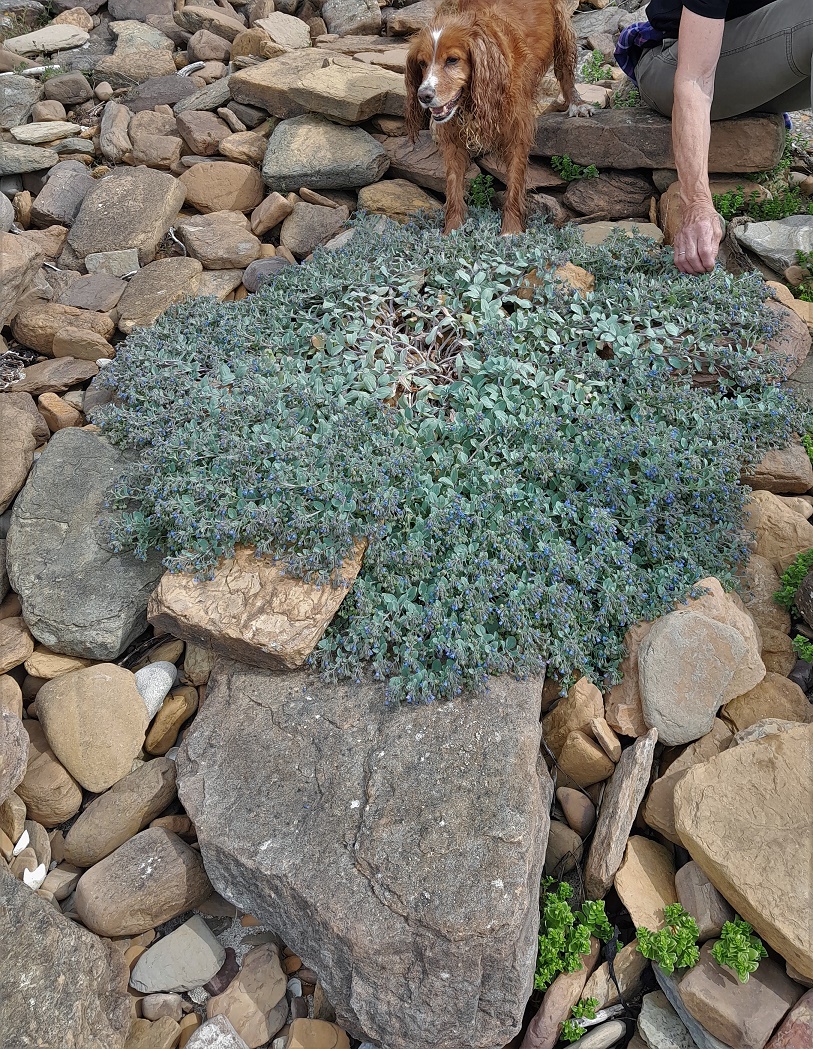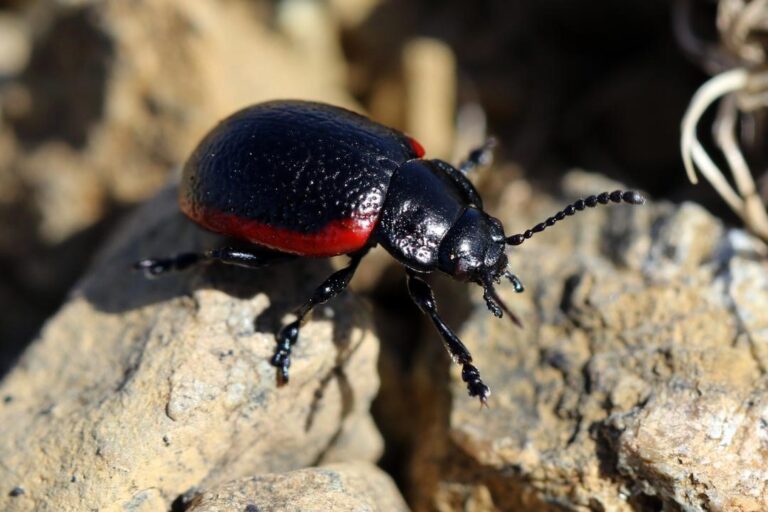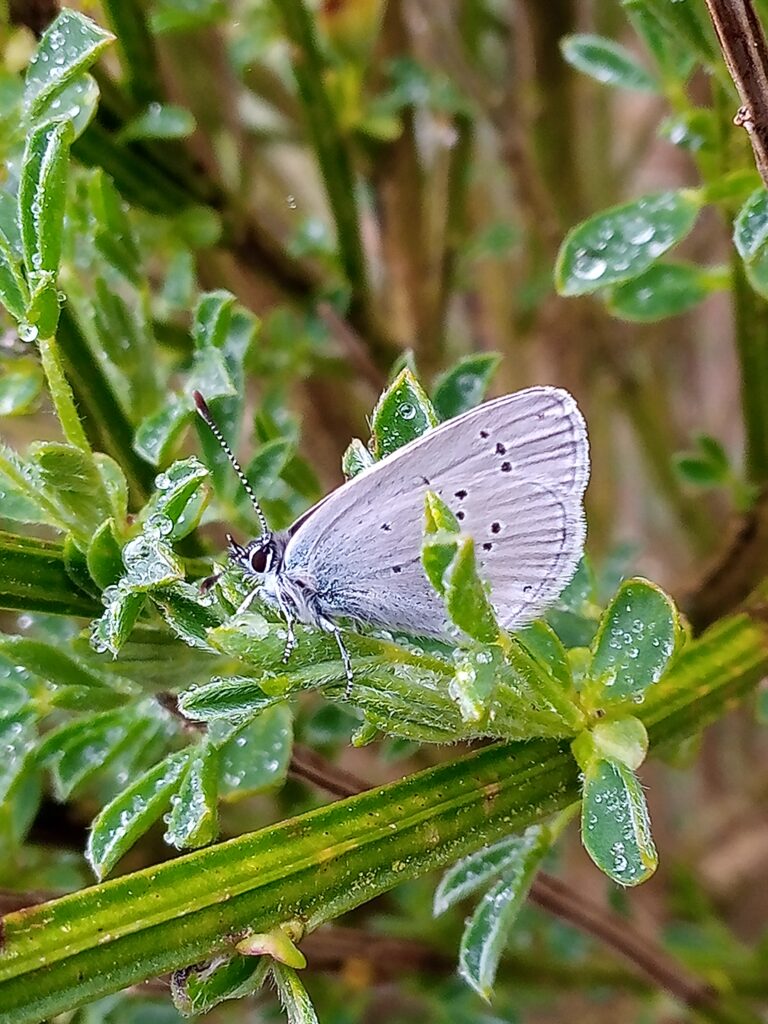
(Mertensia maritima)
Gaelic: tìodhlac-na-mara.
By Sarah Bird, Project Officer, Species on the Edge – North Scotland Coast, working for Plantlife

There are a number of reasons why Oysterplant is fun to find…it is rare, very pretty and occurs in a habitat where it stands out. The Gaelic name means ‘gift-of-the-sea’, and it feels just like a gift when you first find this plant. I first saw it at Castlehill this year.
It is designated as Nationally Scarce in the Vascular Plant Red Data List for Great Britain, and Near Threatened by the Red list – Conservation status of GB species.
Beautiful Oysterplant flowers – video by Lisa Gardner
Now you see me…. Now you don’t!
Oyster Plant is a mobile species, often moving from place-to-place year by year. Searching for it can be a real adventure; frustrating at times, but very rewarding when you are successful…and having a good excuse to walk along the beach in summer is always a win!
Distribution maps for Oysterplant can give the impression that the species is declining. Many colonies, once found and monitored, are seen to decline and fail. Most Oysterplant populations are short-lived, many probably only last a decade or two, and some much less. However, this does not take account of the fact that the species is mobile, and new colonies are most likely starting up in new places while other populations are lost. Coasts where Oysterplants grow are constantly changed by the sea and the weather; events such as storms that damage plant colonies, also spread seeds to new sites. That’s why it’s important for us to keep looking for it in suitable sites each year.
Within Scotland evidence of actual decline is doubtful. The number of Oysterplant colonies at any one time seems to have remained fairly consistent over 150 years. Even in eastern Scotland, where the species was absent for over 50 years, new sites have recently been found. Oysterplant sites tend to be grouped together into regional ‘meta-populations’ with a few strong, long-lived ‘nucleus’ populations, surrounded by short-lived satellite colonies. Some nucleus populations have existed for over a century. The main meta-population areas known in Scotland are:
- East Scotland south of Rattray Head
- North Aberdeenshire to East Ross
- Caithness and Orkney
- Shetland
- Inner Hebrides
Where to look:
Oysterplant Records Map from the NBN Atlas

As a starting point it’s a good idea to look for Oysterplant near where it’s been seen before – either recently, or longer ago. A historic record indicates that seed has reached the coast there previously, and conditions were suitable for a plant to establish, so it could happen again. The north Caithness coast, between Thurso and John O’Groats seems to be our best area for Oysterplant, but there have been sightings from Eilean Hoan, Rispond, Skerray, Kirtomy, Sandside, and Brims too.
The plant grows on gravelly and sandy seashores, at the top of the beach, usually just within reach of the highest winter tides. It is often the land plant that grows nearest to the sea. Plants that maybe growing nearby include Sea Sandwort (Honckenya peploides) and Lyme Grass (Leymus arenarius).

(Mary Legg)

(Mary Legg)

Image © Kristian Peters
On more exposed beaches, like some places in Caithness, it is most likely to be found where the beach is protected by offshore reefs and rocks. Oysterplant likes to grow near streams on the beach, so this is a good place to check too (occasionally plants have been found further up firths and river estuaries.)

How to look/what to look out for:
Oysterplant grows close to the ground forming a mat of stems and leaves that is often roughly cirular. It has branching green or purple stems and blue-grey leaves that look quite thick and succulent. The stunning flowers are pink in bud and change to a lovely blue as they open. Flowers develop at the ends of the growing stems often around the edge of the plant. A strong taproot holds the plant securely in place and reaches deep down through the stones or sand to reach nutrients and freshwater.


(Mary Legg)

(Mary Legg)

(Lisa Gardner)

When to look
Plants start to appear in the stones or sand in May, and flower between June and August. They are at their most obvious in July, when large plants can be over 1.5m in diameter. As they can be damaged by storms it’s best to look for them during calm weather. In winter the leaves and stems die back, and the root system survives underground.
Fascinating facts
- Oysterplant is related to Forget-me-nots and Borage. Flowers that change colour are common in this plant family.
- The leaves are said to taste of oysters, but it’s not a good idea to collect food from such a rare and fragile wild plant. (It is possible to buy seeds and grow Oysterplant in gardens for those who want to try eating it.)
- Oysterplant seeds, called nutlets, float in seawater. They are transported by wind and sea and have been known to travel over 450 km (280 miles). The seeds are not affected by seawater, and can stay dormant for years waiting for the right conditions to grow.
- Oysterplant likes having seaweed dumped on it. Rotting seaweed makes really rich compost that is ideal for plants to grow in. This particularly helps young plants to develop a strong root system in stony ground where there isn’t much soil.
What threats do Oysterplants face?
Slugs and snails love eating Oysterplant so it tends to grow on its own away from other vegetation that could shelter these pests. Sand, cobbles and pebbles dusted by salt spray also deter slugs. Sheep grazing limits the distribution of Oysterplant in Orkney and Shetland. On Fair Isle and on the NW Scotland coast grids and fencing have been used to protect plants. Human damage by trampling, vehicles and gravel collection are also threats.
Climate change could have positive and negative impacts. Oysterplant is adapted to cooler climates so prolonged periods of hot weather may be damaging for plants in summer, and warmer winters could affect seeds which need winter cold to promote germination. However, increasing frequency and severity of storm events may spread seeds more widely.
What can I do?
Regular recording each year is vital to learn more about the species distribution along the north coast. It would be great to find out if we have strong ‘nucleus’ populations here.
Here’s how you can help:
- Go and see Oysterplant and learn what it looks like. The coast between Castlehill and Murkle Bay in Caithness is a good place to start.
- Monitor your beach. Find a beach near you and plan to visit in July each year to look for Oysterplants. Pebble beaches are best, and you just need to walk along the top of the shore where only the highest tides reach.
- Record Oysterplants. Send in your records here.
(Many thanks to Mary Legg and Lisa Gardner for photos and for records.)






